Kawasaki KDX 200 Refresh, Part 1: Renthal Bars, Sprockets and Chain
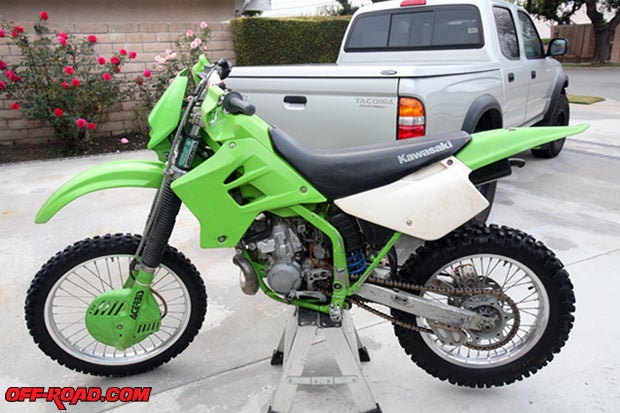
New dirt bikes are great. They come off the showroom floor in pristine condition. No dirt. No scratches. No dents in the pipe. The engine is snappy, the suspension is fresh, and if there are any major mechanical issues it’s covered under warranty.
The only real downside to new dirt bikes is the price. The economy has provided a great deal of opportunity for those looking to buy new, and many manufacturers have either offered discounts, free gear, or lower APRs if you finance. But for some people a new bike just isn’t in the equation right now.
That’s where used dirt bikes enter the picture. Whether it’s three, 10 or 20 years old, there are thousands of great dirt bikes out there to be had. Craig’s List, eBay and your local paper are all great resources to track down used bikes. After keeping our eyes on local Craig’s List ads for a used Kawasaki KDX 200 to serve as our new trail bike, we came across a 2000 model that looked to be a pretty good deal. The owner was asking $1200 but also said he was flexible on the price.
We showed up to check out the 2000 Kawasaki KDX with cash in hand, took it for a spin to check the motor, gave all the mechanicals a once over, and we ultimately felt it was a pretty decent bike. It also doesn’t hurt that the family still rode regularly, so it looked like they knew how to take care of their equipment. Although we won’t be able to dual-sport the two-stroke-powered bike in California, it does have a Green Sticker and can tackle just about any off-road area in the state where dirt bikes are allowed.

We ended up buying the KDX 200 for just under $1000, a price we were happy with and one the seller seemed pleased with since his family really never rode the bike anymore. The KDX has some wear and tear. The pipe had a few dents, the seat a small rip, the plastic scuffed and the frame paint worn off in a few places, but overall the engine felt solid and it was ready to ride as is.
Since we didn’t have a ton of money into the bike, it wouldn’t hurt to invest a little money into bringing the bike back up to speed, or “refresh” it. Before worrying about making changes, we hit the trail a few times to see what we were working with. The bike is actually set up decently for us suspension-wise, but the Renthal bars on the KDX are just too low for a 6-foot-tall rider. Although we plan to replace and update some of the plastic, fix the seat and the exhaust pipe, and even upgrade the handguards, our first change had to be the bars.

While scoping out the Renthal website for different bars, we also came across the company’s line of sprockets and chains and thought this was a worthwhile upgrade. The previous owner said the KDX hadn’t been run a lot in that past few years, but it was clear some of the wear-and-tear parts had seen their fair share of trail time over the years (the bike was more than 10 years old when we purchased it). So replacing the rear sprocket, countershaft sprocket and chain wouldn’t be a horrible idea.
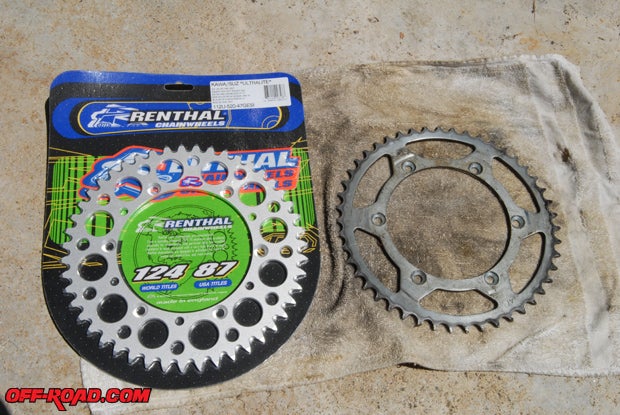
The stock gearing on the 2000 KDX 200 is 13/47. In speaking with our resident dirt bike guru Rick “Super Hunky” Sieman, he suggested we jump up from the 13-tooth countershaft sprocket to a 15-tooth. We actually talked to Vic Krause at Krause Racing’s Sidewinder Sprockets (http://www.sidewindersprockets.com/) who makes such a unit and was happy to send one our way, but after some consideration of our type of riding we chose to stick with the 13-tooth sprocket. Super Hunky used to desert race his KDX in that form, and he loved the way the 15-tooth sprocket pulled off the line. For wide-open desert riding (and even racing) it’s a great way to give the bike longer legs. For our current use and trail riding needs, however, we decided to stick with the stock gearing but will consider the upgrade in the future.
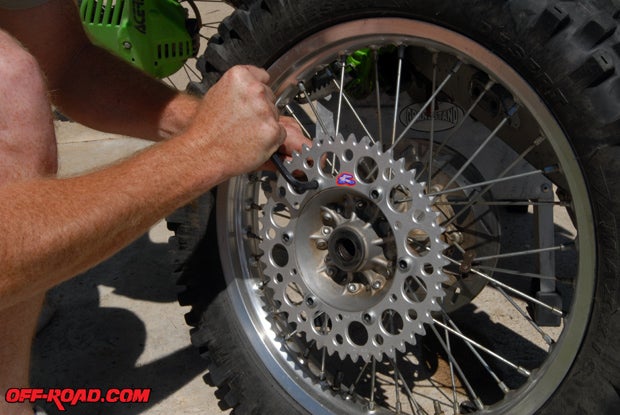
We ended up going with a 13-tooth countershaft sprocket from Renthal, which is constructed of Nickel-Chrome-Molybdenum steel that the company says offers a great combination of strength and hardness. We also decided to replace the rear with Renthal’s Ultralite sprocket. The Ultralite is constructed of 7075 T6 aluminum, which Renthal says is 66 percent lighter than steel. We didn’t weigh it, but it is definitely significantly lighter than our stock piece.
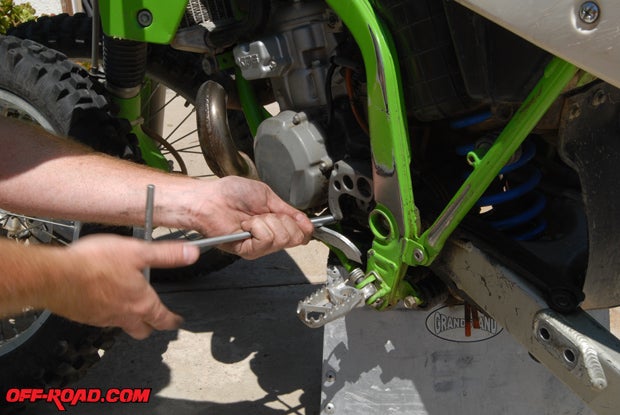
Since we planned to replace the sprockets, it was a no-brainer to swap out the KDX 200’s chain as well. We went with Renthal’s R3-2 O-Ring Chain. This o-ring chain utilizes Nitrile synthetic rubber o-rings that help retain grease in the chain joints. It also is pre-stretched, features shot-peened alloy steel side plates for strength and high-carbon alloy steel bearing pins for wear resistance.
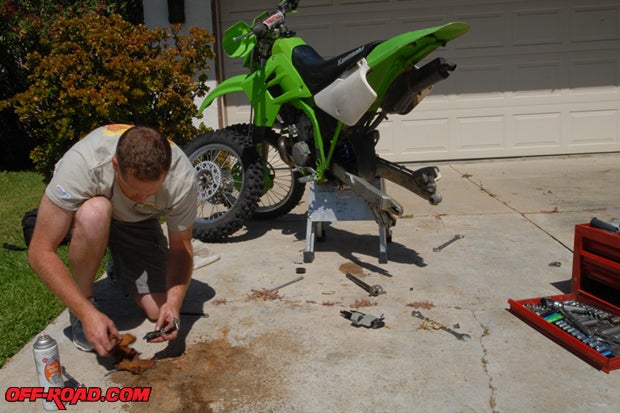
When looking for the proper bend for a new set of bars, the Jimmy Button bend was mentioned by a few people, but Brad Cameron at Renthal actually suggested a new bar called the RC High that doesn’t have as much sweep as the Button bars. To help keep costs down, we went ahead with the 7/8” bar instead of going to the oversized bars.
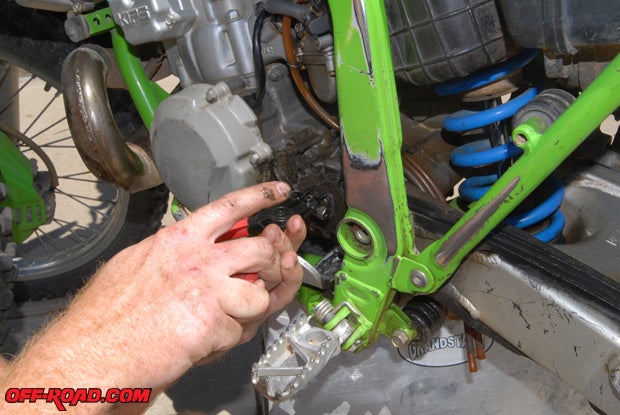
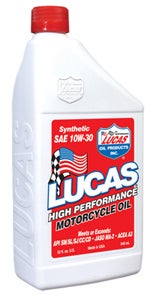 Since we’ve hit the trail a few times on our KDX before making any of these upgrades, we felt it was probably time to change the gearbox oil. Opinions vary on how often your oil should be changed, and much of it depends on how hard a bike is ridden. Some manuals suggest going no more than 10 hours of riding time before a change, but after an all-day ride in the desert (say, 6-7 hours) it’s not a bad idea to swap it out.
Since we’ve hit the trail a few times on our KDX before making any of these upgrades, we felt it was probably time to change the gearbox oil. Opinions vary on how often your oil should be changed, and much of it depends on how hard a bike is ridden. Some manuals suggest going no more than 10 hours of riding time before a change, but after an all-day ride in the desert (say, 6-7 hours) it’s not a bad idea to swap it out.
We turned to Lucas Oil’s 10W-40 oil for our two-stroke motor, as our service manual calls for either 10W-30 or 10W-40. A quick check in our service manual told us that .65 liters of new oil should be used on a change. We actually marked this on our bottle as a reminder just in case the manual wasn’t close at hand. If you’ve recently purchased a used bike, your first purchase should be a service manual – worth every penny. We’ve also used Lucas Oil’s 2-cycle semi-synthetic oil for our pre-mix the last few rides and it has worked great.
Follow along first step in our “refresh” project with our Kawasaki KDX 200. In the near future we plan to upgrade to heavy-duty Acerbis hand guards (http://www.acerbis.com/), replace and repair bumpers and other plastics body pieces, repair our dented FMF Gnarly Pipe with Pacific Crest Pipe Repair (http://www.piperepair.com/), fix our ripped seat with Stomp Design (http://www.stompdesign.com/), and a few other upgrades will certainly pop up along the way.

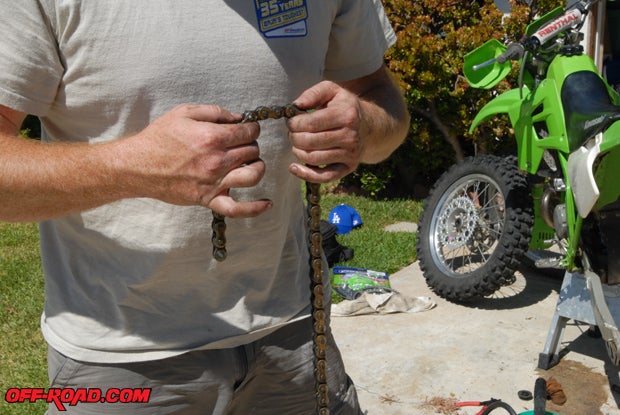
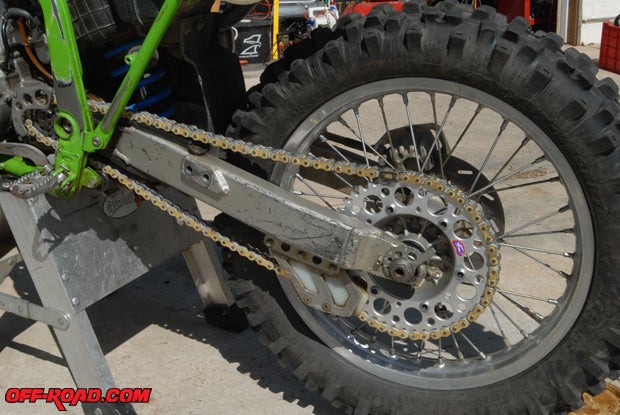
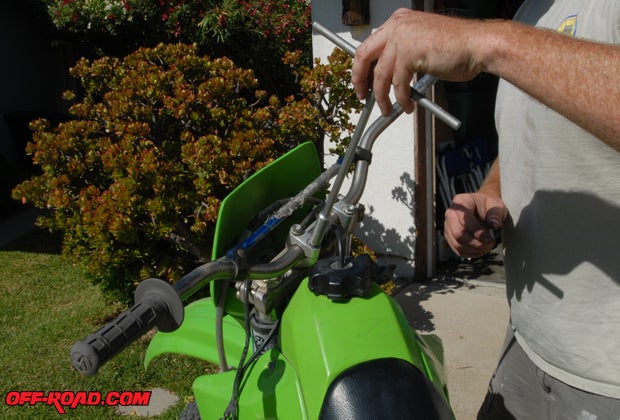

Sources:
Kawasaki
949/770-0400
Kawasaki.com
Lucas Oil
800-342-2512
LucasOil.com
Renthal
877/736-8425
Renthal.com
Krause Racing’s Sidewinder Racing Products
630/513-1000
SidewinderSprockets.com


 Your Privacy Choices
Your Privacy Choices